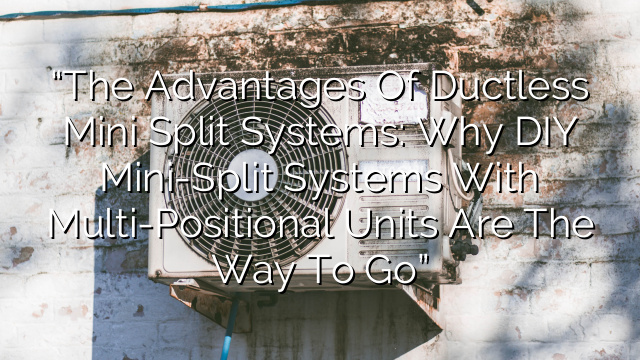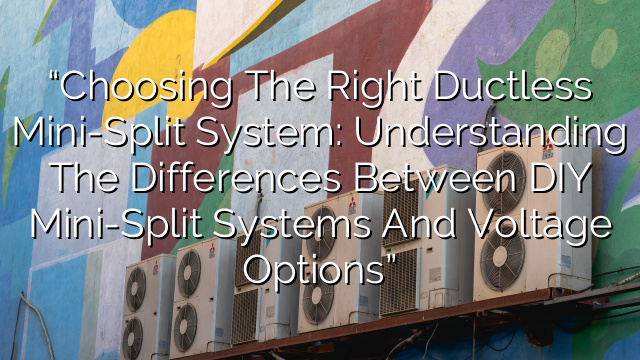If you’re considering a new heating and cooling system for your home, you may have come across ductless mini split systems. These systems are gaining popularity for their energy efficiency, versatility, and installation ease. In this article, we will explore the advantages of ductless mini split systems and why DIY mini-split systems with multi-positional units are the way to go.
Advantages of Ductless Mini Split Systems
Ductless mini split systems have several advantages over traditional HVAC systems. Let’s take a closer look at these benefits:
1. Energy Efficiency: Ductless mini-split systems are highly energy-efficient. Unlike traditional HVAC systems that lose energy through ductwork, ductless systems deliver conditioned air directly to each room. This targeted approach allows for precise temperature control and reduces energy waste.
2. Cost Savings: Due to their energy efficiency, ductless mini split systems can significantly lower your energy bills. Additionally, these systems operate independently in each room, allowing you to adjust the temperature based on your needs. This zoned heating and cooling can lead to further cost savings as you can avoid heating or cooling empty rooms.
3. Easy Installation: Installing a ductless mini split system is relatively easy and straightforward, especially when compared to a traditional HVAC system. Since these systems do not require ductwork, you can avoid the hassle of tearing up walls or installing new ducts. This makes ductless mini split systems an excellent option for retrofitting older homes or adding heating and cooling to specific areas.
4. Versatility: Ductless mini split systems offer great versatility in terms of positioning and design. With multi-positional units, you can customize the layout of the indoor units according to your specific needs. These units can be mounted on walls, ceilings, or even recessed into the ceiling for a seamless appearance. The flexibility in installation options ensures that you can achieve optimal airflow and comfort in any room.
5. Improved Indoor Air Quality: Traditional HVAC systems can accumulate dust, allergens, and other particles in their ductwork, leading to poor indoor air quality. Ductless mini split systems eliminate this concern as they deliver conditioned air directly to each room without passing through ducts. Additionally, some ductless systems offer advanced filtration options, further enhancing indoor air quality.
DIY Mini-Split Systems with Multi-Positional Units
When it comes to ductless mini split systems, there are two options – professional installation or DIY installation. While professional installation ensures expert workmanship, DIY mini-split systems with multi-positional units have their own advantages. Here’s why DIY mini-split systems with multi-positional units are the way to go:
1. Cost Savings: DIY installation can save you a significant amount of money compared to a professional installation. With the right tools and guidance, you can install the system yourself and eliminate labor costs. Additionally, multi-positional units allow for greater flexibility, reducing the need for extra equipment and components.
2. Customization: DIY mini-split systems with multi-positional units allow you to have complete control over the layout and design of your heating and cooling system. You can choose the best location for each unit based on your room layout, aesthetics, and airflow requirements. This level of customization ensures optimal performance and comfort.
3. Learning Experience: Installing a DIY mini-split system is an excellent opportunity to learn about HVAC systems and gain hands-on experience. With the wealth of resources available online, you can educate yourself on the installation process and develop new skills. This knowledge can come in handy for future maintenance or repairs.
4. Convenience: DIY mini-split systems are designed for easy installation. With detailed instructions and user-friendly components, you can complete the installation at your own pace and convenience. This flexibility allows you to fit the project into your schedule and avoid the hassle of coordinating with a professional installer.
5. Sense of Accomplishment: Successfully installing a DIY mini-split system can give you a great sense of accomplishment. You’ll be able to enjoy the fruits of your labor and take pride in a job well done. Additionally, the money saved from DIY installation can be used on other home improvement projects or upgrades.
FAQs about Ductless Mini Split Systems
Q: Are ductless mini split systems suitable for every home? A: Ductless mini split systems are a great option for most homes, especially those without existing ductwork. They work well in single-room applications, multi-room setups, and can also serve as a whole-house solution if properly sized and installed.
Q: Do ductless mini split systems require regular maintenance? A: Like any heating and cooling system, ductless mini split systems require regular maintenance to ensure optimal performance. This includes cleaning or replacing filters, checking the refrigerant levels, and inspecting the indoor and outdoor units. Consult the manufacturer’s recommendations for specific maintenance requirements.
Q: Can I install a ductless mini split system myself? A: Yes, you can install a ductless mini split system yourself, especially with the help of a DIY mini-split system with multi-positional units. However, it’s important to follow the manufacturer’s instructions and local building codes to ensure a safe and proper installation. If you’re not comfortable with the installation process, it’s best to hire a professional.
Q: Are ductless mini split systems noisy? A: Ductless mini split systems are generally quieter than traditional HVAC systems. The indoor units produce noise at around 20 to 30 decibels, which is similar to a whisper. The outdoor units can be slightly noisier but are designed to minimize sound levels during operation.
Q: Can ductless mini split systems provide both heating and cooling? A: Yes, ductless mini split systems can provide both heating and cooling. They use a heat pump technology that can reverse the flow of refrigerant to provide either heating or cooling as needed. This versatility makes them suitable for year-round comfort.
Conclusion
Ductless mini split systems offer numerous advantages over traditional HVAC systems. They are energy-efficient, cost-saving, easy to install, and provide versatility in positioning and design. Choosing a DIY mini-split system with multi-positional units allows for even greater customization, cost savings, convenience, and a sense of accomplishment. Before making a decision, consider your specific heating and cooling needs and consult with a professional to ensure the right system for your home. With the many benefits they offer, ductless mini split systems are a smart choice for efficient and comfortable home heating and cooling.














